Help us protect the commons. Make a tax deductible gift to fund our work. Donate today!
It’s July 20, 1969.
Along with 600 million people, nine-year-old Chris Hadfield is glued to his television—watching intently as American astronaut Neil Armstrong glides down the ladder of the Lunar Module, and in one swift pounce, touches the dust of a familiar yet alien world. His words forever immortalized, “That’s one small step for man, one giant leap for mankind.”
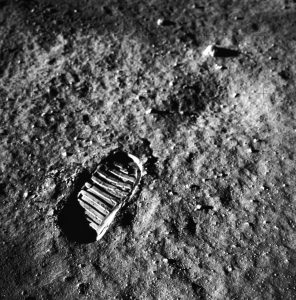
A close-up of an astronaut’s footprint in the lunar soil, photographed by a 70 mm lunar surface camera during the Apollo 11 mission. This image is in the public domain via NASA.
“To see that successfully carried out against what seemed like impossible odds for the first time in human history,” Hadfield recalled in 2012, “was hugely inspiring.” That moment sparked his lifelong journey to become an astronaut; which he did, becoming the first Canadian to walk in space in 2001. In the 1990s, Haley Harrison first heard Armstrong’s words on an educational tape about space. “I was very young, probably 4 or 5 years old,” she recollected, “I just listened to the tape over and over. I would imagine myself on the shuttle…and I would pretend I was going up to space.” Harrison is now a Ph.D. candidate studying nanoscience at The University of North Carolina at Greensboro, with goals of working in the space industry.
NASA is not only required by law (e.g. the U.S. Copyright Act of 1976) to give the public access to many of its materials, the Agency really wants people to use them.
Footage and audio of the Apollo 11 Commander Neil Armstrong and lunar module pilot Buzz Aldrin hopping on the Moon’s surface in 1969 have been remixed, remastered, and reshared countless times—inspiring generations of everyday citizens, like Hadfield and Harrison, to engage with space science and exploration. In fact, the use of materials created by the National Aeronautics and Space Administration (NASA) to create new works for the public doesn’t end with Armstrong’s history-making first steps. For example, Alex G. Orphanos, a science communicator, engineer, and host of the Today in Space podcast, has put NASA’s materials to use for over six years. In particular, he has used images from the Hubble Space Telescope and information from NASA Procurement to better explain space-related issues to his audience. Rachael Eidson, a business development specialist for Trenton Systems and social media influencer also routinely uses NASA’s images in her collaborations with eco-fashion and accessory companies. In fact, it’s hard to miss the resurgence of space-themed items, including t-shirts, mugs, bags, etc. featuring NASA’s “meatball” logo. As the L.A. Times reported in 2019, “The NASA logo is having a moment.”
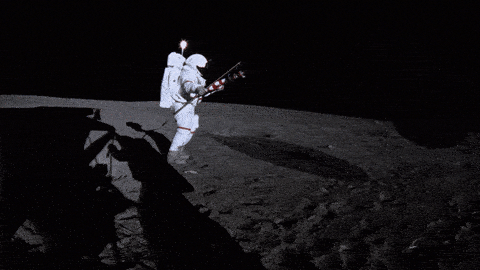
Astronauts Neil Armstrong and Buzz Aldrin unfurl the American flag on the Moon’s surface on July 20, 1969. This animation is in the public domain via NASA.
From documentaries to basketball shoes, works utilizing NASA’s materials are everywhere; and at some point, while browsing NASA-themed goods online or watching clips of launches on Youtube, you may have wondered why and how these materials are used so widely and freely. Isn’t there some sort of intellectual property (IP) infringement going on? The short answer is, no. In fact, NASA is not only required by law to give you access to many of those materials, it actually really wants you to use them—here’s why.
NASA’s openness is intrinsically linked to its mission
NASA’s commitment to sharing its work openly with the public has, arguably, been there since its creation in 1958. NASA was established in the midst of a galactic battle for scientific and innovation dominance between the Soviet Union and the United States (U.S.) during the Cold War. Within this context, the Agency’s primary function was civilian in nature, unlike the Advanced Research Projects Agency (later, DARPA) also created in 1958. Under the National Aeronautics and Space Act, NASA was tasked with encouraging “peaceful applications in space science” and “expanding the frontiers of knowledge, advancing the understanding of the universe, and serving the American public.” Of course, at the time, generating public interest in space exploration was necessary to “win” the Space Race. Space exploration, especially when publicly funded, only happens if people are interested and willing to dedicate resources. In fact, one of the reasons NASA stopped going to the Moon in the 1970s was waning public and political interest, which led to the Agency drastically cutting its programs and activities.
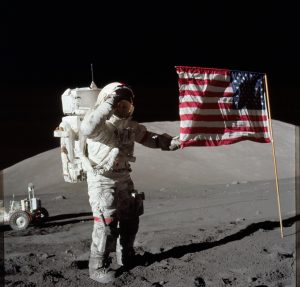
Apollo 17 Commander Eugene A. Cernan is photographed next to the U.S. flag in 1972—marking NASA’s final mission to the Moon. This image is in the public domain via NASA.
Openness is therefore linked to the Agency’s mission, one that requires transparency to generate public support. “As a government agency, NASA wants to tell taxpayers what we’re doing with their money and why we think it’s important. We do that through everything from scientific papers to our social media feeds and NASA TV coverage of live events,” explained Brian Dunbar, internet services manager/COMIT task order manager at the NASA Office of Communications, over email. “That’s also true for researchers, as openly shared data is the best way to increase the amount of research for any mission.”
Space exploration only happens if people are interested and willing to dedicate resources. Openness is therefore linked to the Agency’s mission, one that requires transparency to generate public support.
However, we can’t ignore the very real and rather dry legal instruments that underpin this openness, particularly to NASA-produced images, research, and publications. Under the U.S. Copyright Act of 1976, a work by the U.S. federal government is defined as “a work prepared by an officer or employee as part of that person’s official duties.” These works are generally not subject to domestic copyright protection under section 105 of the Copyright Act and are therefore released into the public domain. Therefore, the footage and audio captured during Apollo 11, or during any of NASA’s missions by NASA itself should, in theory, be released into the public domain. This also includes NASA-funded research.
To make matters complicated, it’s not always clear what works fall under section 105 of the Copyright Act. For example, if a government publication includes works that are developed by a third party contractor or grantee, then it may be subject to copyright. In addition, the U.S. government can still assert copyright in other countries. To help create clarity and open access to all public research, in particular, the White House Office of Science and Technology Policy (OSTP) issued an executive order in 2013. This memorandum aimed to ensure that federally funded research would be made publically accessible within one year of publication. In response to the 2013 executive order, NASA created an agency-wide plan titled, “NASA Plan for Increasing Access to the Results of Scientific Research,” and a specific policy. Ultimately, the plan served as a reaffirmation of NASA’s existing “open-access culture” by “promoting the full and open sharing of data with research communities, private industry, academia, and the general public…[including] data and publications for all of the scientific research that the Agency sponsors.” Over the last decade, NASA has also created several iterations of an “Open Government Plan” to apply the principles of open government, including “participation, transparency, and openness.”

Business Development Specialist and influencer Rachael Eidson wears space-themed outfits for her Instagram @cosmicrachael.
In cases where a work is not clearly and/or automatically placed into the public domain, NASA often uses CC licenses or public domain tools to indicate the work is free to reuse. Of course, it’s preferred that the Agency utilize more open licenses, like CC BY or CC BY-SA, rather than the more restrictive Non-Commercial (NC) or No Derivatives (ND) licenses to allow more opportunities for others to reuse, remix, or reshare their work. Other space agencies have also utilized CC licenses to share their work, including the European Space Agency which published its open access policy in 2017 and opted for CC BY-SA.
As far as NASA’s logos and insignia are concerned (e.g. the “meatball” logo), those fall under a complex mix of trademark law and regulations. As a government entity, NASA doesn’t license out their logos or receive profit from merchandise, but they do have strong usage restrictions and clear guidelines when it comes to merchandising and the media. Therefore, users must submit their designs to the Multimedia Division of NASA’s Office of Communications for approval.
For citizen scientists, researchers, and innovators, NASA is an invaluable resource
A core theory of the open movement is that the ability to access, remix, and share creative works and knowledge leads to further innovation, discovery, and creativity. NASA’s work has routinely proven that theory correct. The Agency actively makes its research, data, and content more accessible through a variety of data platforms, software catalogs, and citizen science programs. These include the Scientific and Technical Information Program site and the NASA Technical Report Server, as well as NASA’s Data Portal and PubSpace which house results from NASA’s scientific research and published papers. For coders and developers, NASA has several repositories at Open NASA and {NASA APIs}; and for creatives, NASA HQ Photo on Flickr, the NASA Image and Video Library, Planetary Photojournal, and Earth Observatory are great resources for openly licensed content.
Using publicly accessible data from NASA’s Kepler telescope, citizen scientists and university students recently discovered a new planet “roughly twice the size of Earth.”
These efforts by NASA have led to important breakthroughs and collaborations in unexpected places. For instance, using publicly accessible data from NASA’s Kepler telescope, citizen scientists and university students recently discovered a new planet “roughly twice the size of Earth.” In fact, many students studying space science and technology use NASA’s resources for their work, routinely tapping into their publicly shared and easily accessible research papers, patents, and archived presentations. Harrison, for instance, said she has NASA to thank for a portion of her dissertation topic on aerogels. Also known as “frozen smoke,” these lightweight, synthetic, and porous materials have a density close to that of air, and thanks to work by NASA’s Jet Propulsion Laboratory in the 1990s, aerogels are now used in space exploration. To achieve the required low density, explained Harrison, “aerogels are delicately dried using a special process that involves a supercritical dryer.” Unable to get access to this unique piece of equipment at her university, she was granted access to one at NASA’s Glenn Research Center, “It would have been impossible for me to do this work without their help!”
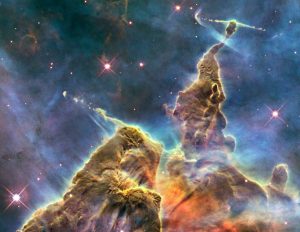
Carina Nebula’s ‘Mystic Mountain,’ imaged by the NASA Hubble Space Telescope in 2010, is one of the most viewed images in NASA’s library. This image is in the public domain via NASA, ESA, M. Livio, and the Hubble 20th Anniversary Team (STSc).
Finally, Dunbar was eager to point out NASA’s Technology Transfer Program, which is designed to “put NASA technology into wider use” through its patent licensing program. “NASA is well-known for spinoffs: commercial products that use technology created or further developed by or for NASA,” he explained. Think memory foam and emergency blankets, but not Tang or Velcro. More recently, in response to the COVID-19 pandemic, NASA’s Jet Propulsion Laboratory (JPL) signed onto the Open COVID Pledge and released the designs for three respirators so they can be used by anyone, anywhere.
Does NASA prove the power of open?
It’s a critical moment for NASA. In just a few days, the Demo-2 mission (a.k.a. “Launch America”) is set to mark the first time NASA will launch astronauts to the ISS from American soil since 2011. In just a few years, NASA also plans to return to the Moon through the Artemis program, and eventually, venture further to Mars. A “new era of human spaceflight” is coming and not since the 1960s has NASA needed and sought after such political and public support.
NASA is well aware that by opening access to its activities and research it promotes its mission and work, but Orphanos argues the Agency’s openness is also vital for space exploration and science more generally. “NASA still holds a unique position of respect and brand to people as a resource,” he explained. Therefore, it helps dismantle disinformation or misinformation about space and space-related endeavors. Harrison agreed, “Many people still believe the moon landing was fake…We live in a world where it is easier to read and share stories from Facebook than it is to access historical footage and dynamic scientific data that is easy for our community at large to understand.” That’s why, she emphasized, it’s the job of those active in the sciences to openly and clearly share information with the public.
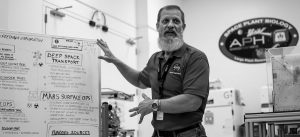
Ralph Fritsche, senior project manager for Space Crop Production at NASA, explains the future of food in deep space during a NASA Social tour. This image is licensed CC BY via Victoria Heath.
It’s also no secret that space is becoming more commercialized, evident in NASA’s Commercial Crew Program, and thus more competitive, crowded, and to some, exclusive. “I once heard someone say, ‘Space belongs to the rich,’” Eidson explained, “It made me cringe a bit because I could see the truth in it.” This points to an increasingly important result of unfettered access to resources from publicly funded space agencies: it helps maintain the original ethos expressed in the 1967 Outer Space Treaty—that space belongs to everyone.
Without public access to space science and activities, we risk making outer space the province of only the privileged. More than it already is. We risk discouraging everyday citizens to look towards the cosmos with curiosity, hope, and pride. Ultimately, we risk never inspiring individuals like Chris Hadfield to become astronauts or Haley Harrison to become students of space science. “Knowing that humans had achieved such a feat, to walk on the Moon, was a huge source of inspiration for me,” she expressed, “I learned very young that the sky was not a limit and there was endless potential beyond what my eyes could see.” Boiled down to its simplest essence, the power of “open” lies in its ability to create a better world through sharing. In the past, NASA has routinely illustrated this power—the hope is that it continues to do so.
This post is one in a series exploring openness “in the wild” to understand the tangible outcomes of implementing open policies and practices. So far, we’ve written about open access to scientific research (here and here) and open-source medical hardware during the COVID-19 pandemic (here); and interviewed the President of The Hewlett Foundation to understand how they’ve implemented an open licensing requirement for grantees (here). More to come!
Posted 25 May 2020